
Introduction
There's been a real surge in popularity of the
ultra-wide market for desktop monitors, with a decent range of screens
now available to suit most needs. There's more general all-round displays from the
likes of
Dell and
LG available, with flat and curved models available. Then there's some more
specialist, gamer-orientated displays around like the
Acer Predator X34 and
Asus ROG Swift PG348Q for instance, offering high end gaming features like
G-sync and overclocked 100Hz refresh rates. What has attracted many people to
this sector is the large screen size and high resolution of most models, with
3440 x 1440 being the preferred option above a hand full of 2560 x 1080 screens
also available. The ultra-wide format with a 21:9 aspect ratio is an interesting
format for split screen multi-tasking, as well as immersive wide screen gaming
and models primarily in the 34" size range have really taken off. LG are set to
the first to offer something a little different with their new 38UC99 display.
According to their website, the LG 38UC99 is aimed
primarily at "designers, photographers, producers and other creative
professionals who need more room for big ideas". Although the screen also
boasts a fair few features for other users, including the gaming audience. There
is AMD FreeSync support, a slightly boosted 75Hz refresh rate (above the normal
60Hz from most screens), a variety of gaming enhancements and options and even
LG's new "1ms Motion Blur Reduction" mode. This is a new, larger format screen
offering a 37.5" diagonal in a curved format, while maintaining a similar aspect
ratio to the popular 34" models around. LG actually refer to this as a 21:9
aspect ratio ultra-wide screen on their website, but it is in fact slightly different at
24:10 (or 12:5 if you'd rather). The resolution is also a little higher than the 34" models at 3840 x
1600, and there's a wide range of features and extras included. While this
screen isn't aimed at gamers, the additional gaming enhancements will certainly
be tested throughout this review.
If you appreciate the review and enjoy reading and like our work, we would welcome a
donation
to the site to help us continue to make quality and detailed reviews for you.
|
Check Pricing and Buy - Affiliate Links
|
|
Amazon
|
|
TFTCentral is a participant
in the Amazon Services LLC Associates Programme, an affiliate
advertising programme designed to provide a means for sites to earn
advertising fees by advertising and linking to Amazon.com, Amazon.co.uk,
Amazon.de, Amazon.ca and other Amazon stores worldwide. We also
participate in a similar scheme for Overclockers.co.uk. |

Specifications and Features
The following table gives detailed information
about the specs of the screen:
|
Monitor
Specifications |
|
Size |
37.5"WS |
Panel Coating |
Light AG coating |
|
Aspect Ratio |
24:10 (12:5) curved |
Interfaces |
1x DisplayPort
(version 1.2a), 2x HDMI 2.0, USB Type-C
|
|
Resolution |
3840 x 1600 QHD+ |
|
Pixel Pitch |
0.229 mm |
Design
colour |
3-side zero frame design with silver edge and
stand. Glossy white back |
|
Response Time |
5ms G2G |
Ergonomics |
Tilt and 110mm height |
|
Static Contrast Ratio |
1000:1 |
|
Dynamic Contrast Ratio |
'Mega' |
VESA Compatible |
Yes 100mm |
|
Brightness |
300 cd/m2 |
Accessories |
Power cable and brick, DisplayPort, HDMI and
USB type-C cables (all white colour) |
|
Viewing Angles |
178 / 178 |
|
Panel Technology |
LG.Display AH-IPS |
Weight |
with stand: 9.3 Kg |
|
Backlight Technology |
W-LED |
Physical Dimensions |
(WxHxD)
897.2 x 466.2 x 230.4 mm |
|
Colour Depth |
1.07b (8-bit+FRC) |
|
Refresh Rate |
60Hz -
75Hz
FreeSync range 52 - 75Hz |
Special
Features |
2x
USB 3.0 ports with charging, Factory calibration and report, 1x headphone
output, 2x 10W speakers with Bluetooth support, FreeSync, PbP, Motion Blur Reduction mode |
|
Colour Gamut |
Standard gamut
over
99% sRGB, ~72% NTSC |
The 38UC99 offers a good range of connectivity
options with DisplayPort 1.2a, 2x HDMI 2.0 and USB type-C connections
offered. HDMI 2.0 will support the full native resolution at 60Hz. DisplayPort
will support refresh rate up t0 75Hz, including FreeSync support from compatible
AMD graphics cards (52 - 75Hz range). For those unfamiliar with USB type-C, this
interface can provide a single connection for video (60Hz, no FreeSync) as well
as directly connecting the screen to PC via USB for data transfer and powering the
on-board USB 3.0 ports, all through a single cable. The
digital interfaces are HDCP certified for encrypted content and the video cables
are provided in the box for DisplayPort, HDMI and USB type-C.
The screen has an external power supply and comes
packaged with the power cable and rather large power brick you need. There are also 2x USB 3.0 ports located
on the back of the screen with the video connections with one have charging
capabilities as well. An audio headphone jack is also provided in case you don't
want to use the built-in 2x 10W speakers. There's even a USB Bluetooth dongle
which connects to the monitor and allows you to link your phone or other
Bluetooth device to the screen and play music and audio through the speakers.
Below is a summary of the features and connections
of the screen:
|
Feature |
Yes / No |
Feature |
Yes / No |
|
Tilt adjust |
 |
DVI |
 |
|
Height adjust |
 |
HDMI |
 |
|
Swivel adjust |
 |
D-sub |
 |
|
Rotate adjust |
 |
DisplayPort |
 |
|
VESA compliant |
 |
Component |
 |
|
USB 2.0 Ports |
 |
Audio connection |
 |
|
USB 3.0 Ports |
 |
HDCP Support |
 |
|
Card Reader |
 |
MHL Support |
 |
|
Ambient Light Sensor |
 |
Integrated Speakers |
 |
|
Human Motion Sensor |
 |
PiP / PbP |
 |
|
Touch Screen |
 |
Blur Reduction Mode |
 |
|
Factory Calibration |
 |
G-Sync |
 |
|
Hardware calibration |
 |
FreeSync |
 |
|
Uniformity correction |
 |
Wireless charging |
 |

Design and Ergonomics


Above: front views of the screen. Click for larger versions
The 38UC99 comes in an attractive design with a
three-side zero bezel panel. There is a thin 2.5mm silver trim around the
sides and top of the screen, and then a 9mm black border to the panel
before the image actually starts. Along the bottom edge is a black bezel
measuring ~11mm thickness and then a 2mm black panel border. As a result
of these borders, the screen looks pretty similar around all 4 sides in
terms of a border before the image. There is a grey LG logo in the middle
of the bottom bezel but no other markings or writing on the front of the
screen anywhere. The panel curves towards you from the slides, but it is a
subtle 2300R curvature. It does make using the screen more natural given
the large size and wide format though. The screen is very large,
noticeably more so than the 34" screens even which seem huge when you first
connect them. You soon get used to the massive size though and it becomes a
pleasure to use.


Above: rear
views of the screen. Click for larger versions
The back of the screen is encased in a glossy
white plastic which is quite unusual really in today's market. It looks
sleek and attractive and isn't overly reflective. The stand attaches in
the middle at the back as you can see above, and can also be removed to
reveal VESA 100 compliant mounting support. The connections are on the
back of the screen next to the stand as you can see. On the back of the
stand you can attach a small provided cable tidy clip (white in colour)
which is handy. The base of the stand is finished in a matte silver
aluminium style and has a curved shape as well. It looks decent on the
desk and provides a stable base for the large and heavy screen.

Above: view
from above the screen showing thin profile
The display has a nice thin profile with a 91.5mm
thickness, thanks to the use of a W-LED backlight unit and an external
power supply.



Above: side
views of the screen shown. Click for larger versions
The screen offers height and tilt adjustments from
the stand, but does not have side to side swivel which is a bit of a shame
and would have been handy. There is no rotate adjustment which would have
been impractical on a screen as big as this. Because the screen is so
large and heavy, and because the stand attachment is relatively small on
the back (100mm x 100mm) there is some wobble from the screen if you knock
it, or as you re-position things. During normal use, keyboard and mouse
use doesn't cause any wobbling though on the desk.
Height adjustment is also available with
smooth movement but is quite stiff to move. At the
lowest setting the bottom edge of the screen is ~80mm from the top of the
desk, and at maximum extension it is ~190mm. This gives a total adjustment
range of ~110mm which is decent and as advertised.
A summary of the screens ergonomic adjustments
is shown below:
|
Function |
Range |
Smoothness |
Ease of Use |
|
Tilt |
Yes |
Smooth |
Easy |
|
Height |
110mm |
Smooth |
Quite stiff |
|
Swivel |
No |
- |
- |
|
Rotate |
No |
- |
- |
|
Overall |
Tilt and height are easy
enough to use, but missing swivel which was a shame. Some wobble from the
screen |
The materials were of a good standard and the
build quality felt very good as well. There was no audible noise from the screen,
even when conducting specific tests which can often identify buzzing issues.
The whole screen remained cool even during prolonged use as well which
was pleasing.

Above:
interface connections
The back of the screen features the interface
connections as shown above. There are USB type-C, DisplayPort, 2x HDMI 2.0, 2x
USB 3.0 (one with charging support), a headphone jack and the power connection. They
are pretty easy to get to although because there's no swivel adjustment from the
stand it can be a bit cumbersome trying to get behind the screen if you want to
change connections or plug/unplug anything.

"With USB Type-C™, Display Connection, users
can transfer data and charge your latest Macbook or mobile device, all at the
same time using a single cable. Charge your Android phone with USB 3.0 Quick
Charge at the same time. Simplify your work space without the hassle of wires."

"Enjoy the enriched sound
of 10W x 2 Stereo speakers featuring Rich Bass that adds to a deeper and wider
sound experience covering from 85Hz unlike built-in speakers in conventional
monitors. Easily connect to your mobile device via wireless Bluetooth Audio
connection creating listening pleasure."

OSD Menu
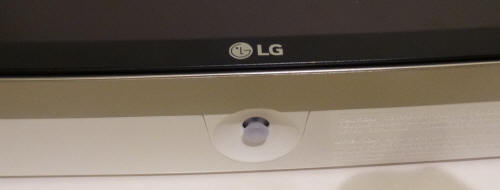
Above: OSD control joystick on the bottom edge of the screen in the middle Click for larger
version
The OSD menu is controlled through a single
joystick control located on the bottom edge of the screen in the middle. It is a
pressable button as well which glows white during normal operation, and flashes
on/off white when the screen is in standby. This flashing is actually a little
annoying, as it's fairly bright and you can see it reflecting against the stand
and desk quite easily. Powering the screen off instead of leaving it in standby
fixes that though as the LED is then turned off.
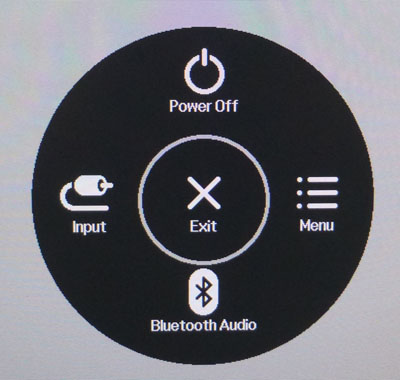
Pressing the joystick up or down (i.e. away from
you or towards you) pops up a confirmation of your current input connection, as
well as the active preset mode. You can't actually change anything though from
this pop-up menu oddly. Pressing the joystick left or right allows you to adjust
the volume control. You have to press the joystick button in to bring up any
other menus. First you get the above quick access menu which sadly you aren't
able to customise to options you'd prefer to have access to. You can quickly
switch between inputs here and enable/disable the Bluetooth if you want. We
aren't really sure why anyone would really need quick access to be able to turn
the Bluetooth on and off though, we'd have preferred access to something else
here. You can also enter the main menu by pressing right on the joystick from
this quick access first menu.
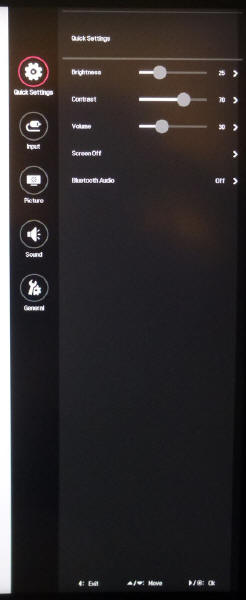
Above: full top
to bottom view of the OSD menu. Click for larger version
When you enter the main menu, a large OSD is shown
on the right hand side of the screen, spanning from top to bottom. It's a big
menu in size as you can see from the image above! The menu itself is split in to
5 sections down the left hand side. You can navigate quite easily using the
joystick, although you do sometimes have to drill through several levels to get
where you want. Once closed, the menu won't remember where you last were either,
so you have to start navigation again. The options available in each of the 5
sections are shown on the right hand side. We have cropped the images below to
show you just the available options, rather than a full view of the OSD software
from top to bottom of the screen each time to save a bit of room.
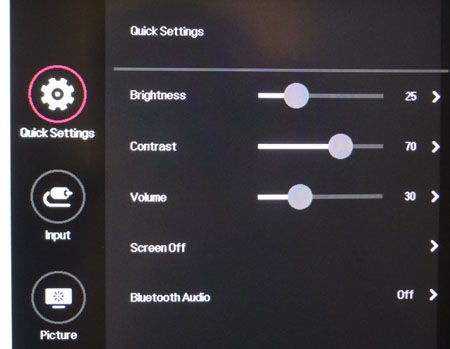
The first 'quick settings' menu has options to
control the brightness, contrast and volume, along with a couple of other
options.
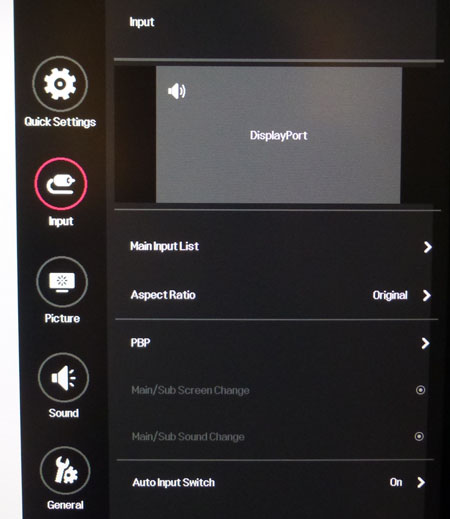
The input menu allows you to switch between the
video inputs as well as control the hardware aspect ratio setting and the
picture by picture (PbP) options. This is only really an option to split the
screen in half if you want to show two inputs at the same time, with an even
half/half split. No further PiP or PbP options are available which is a shame as
the screen is so large, a variety of configurations would have been useful to
some people.
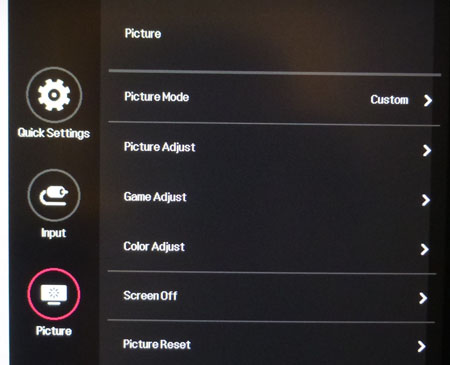
The 'picture' menu has most of the other settings
in it. You can adjust the preset mode via the 'picture mode' option. The
'picture adjust' section allows you to change brightness, contrast, sharpness
and turn the dynamic contrast ratio on if you want.
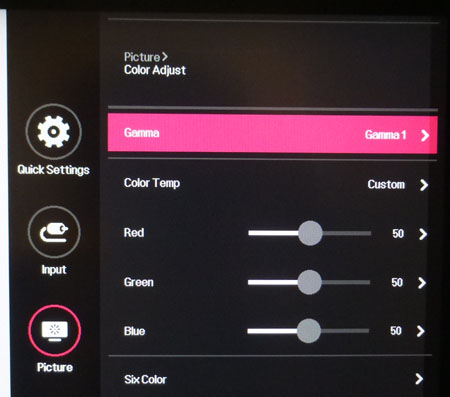
The 'color adjust' section allows you to change
the gamma setting, colour temp and adjust the RGB channels.
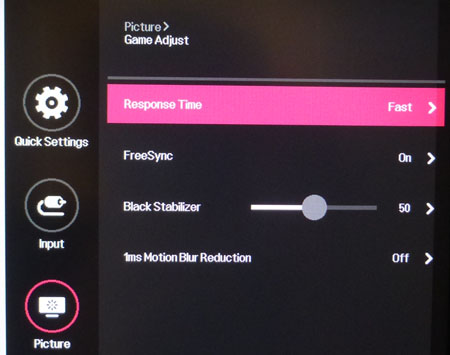
The 'game adjust' section allows you to alter the
response time setting, turn FreeSync on/off and also has the Blur Reduction mode
available. We will test all of these functions
later in the
review.
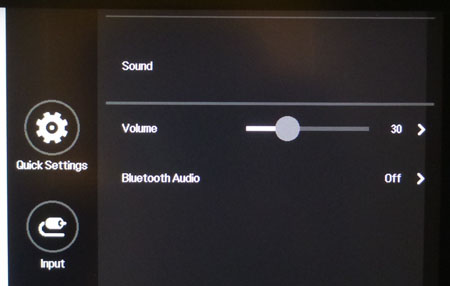
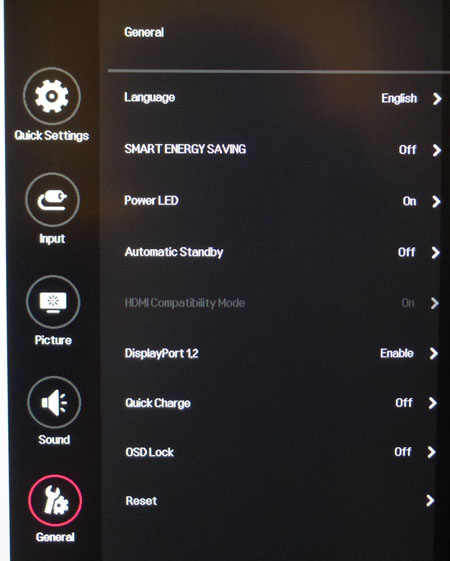
The 'sound' section of the menu is pretty self
explanatory, as is the 'general' section shown above.
All in all there were a decent range of options
available in the menu and a good control over most things. We would have liked
the option to change the quick access options really, and some of the navigation
got a bit tiresome through many levels of menu to get to where you want.
Navigation was pretty intuitive thanks tot he joystick though, but the software
felt a little big and chunky in the way it was presented.

Power Consumption
In terms of power consumption the manufacturer
lists typical 'on' usage of 57W and 1.2W in standby. We carried out our normal tests to
establish its power consumption ourselves.
|
 |
|
State and Brightness
Setting |
Manufacturer Spec (W) |
Measured Power Usage
(W) |
|
Default (100%) |
57.0 |
60.1 |
|
Calibrated (24%) |
- |
35.0 |
|
Maximum Brightness (100%) |
- |
60.1 |
|
Minimum Brightness (0%) |
- |
28.5 |
|
Standby |
1.2 |
1.1 |
|
We tested this ourselves and found that out of the
box the screen used 60.1W at the default 100% brightness setting. Once calibrated the screen reached
35.0W consumption, and in standby it
used only 1.1W. We have plotted these results below compared with other screens
we have tested. The consumption is comparable to the other large ultra-wide
screens we have tested as you might expect, with some of the smaller screens
drawing less power (comparing the calibrated states).


Panel and Backlighting
|
Panel Manufacturer |
LG.Display |
Colour Palette |
1.07 billion |
|
Panel Technology |
AH-IPS |
Colour Depth |
8-bit+ FRC |
|
Panel Module |
LM375QW1-SSA1 |
Colour space |
Standard gamut |
|
Backlighting Type |
W-LED |
Colour space coverage (%) |
99% sRGB, ~72% NTSC |
Panel Part and Colour Depth
The LG
38UC99 features a
LG.Display LM375QW1-SSA1 AH-IPS technology panel which is capable of producing
1.07 billion colours. This is achieved through a 8-bit+FRC colour depth as
detailed in LG's specification. Keep in mind whether this 10-bit support is
practically useable and whether you're ever going to truly use that
colour depth. You need to have a full 10-bit end to end workflow to take
advantage of it which is still quite expensive to achieve and rare in the
market, certainly for your average user. This includes relevant applications and
graphics cards as well, so to many people this 10-bit support might be
irrelevant. This is the first panel of this size and format we have seen. The
panel part is confirmed when dismantling the screen as shown below:
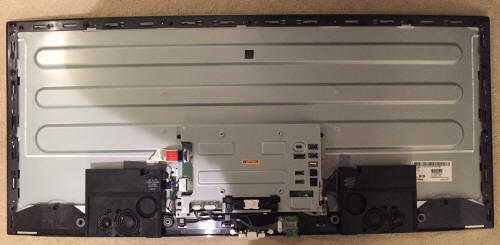
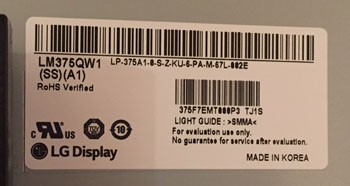
Screen
Coating
The
screen coating is a light anti-glare (AG) offering. It isn't a semi-glossy
coating, but it is light as seen on other modern IPS type panels. Thankfully it
isn't a heavily grainy coating like some old IPS panels feature and is also
lighter than modern TN Film panel coating. It retains its anti-glare properties
to avoid too many unwanted reflections of a full glossy coating, but does not
produce an too grainy or dirty an image that some thicker AG coatings can.
Backlight Type and Colour Gamut
The screen uses a White-LED (W-LED) backlight unit
which is standard in today's market. This helps reduce power consumption
compared with older CCFL backlight units and brings about some environmental
benefits as well. The W-LED unit offers a standard colour gamut which is
approximately equal to the sRGB colour space. LG quote 99% coverage in their
spec. Anyone wanting to work with wider colour spaces would need to consider
wide gamut CCFL screens or the newer range of GB-r-LED type (and similar)
displays available now. If you want to read more about colour spaces and gamut
then please have a read of our
detailed article.
Backlight
Dimming and Flicker
We tested the screen to establish the methods used
to control backlight dimming. Our in depth article talks in more details about a
common method used for this which is called
Pulse Width Modulation (PWM). This in itself gives cause for concern to some
users who have experienced eye strain, headaches and other symptoms as a result
of the flickering backlight caused by this technology. We use a photosensor +
oscilloscope system to measure backlight dimming control
with a high level of accuracy and ease. These tests allow us to establish
1) Whether PWM is being used to control the
backlight
2) The frequency and other characteristics at which this operates, if it is used
3) Whether a flicker may be introduced or potentially noticeable at certain
settings
If PWM is used for backlight dimming, the higher
the frequency, the less likely you are to see artefacts and flicker. The duty
cycle (the time for which the backlight is on) is also important and the shorter
the duty cycle, the more potential there is that you may see flicker. The other
factor which can influence flicker is the amplitude of the PWM, measuring the
difference in brightness output between the 'on' and 'off' states. Please
remember that not every user would notice a flicker from a backlight using PWM,
but it is something to be wary of. It is also a hard thing to quantify as it is
very subjective when talking about whether a user may or may not experience the
side effects.
100% 50%
0%



Above scale = 1
horizontal grid = 5ms
At 100% brightness a constant voltage is applied
to the backlight. As you reduce the brightness setting to dim the backlight a
Direct Current (DC) method is used, as opposed to any form of PWM. This applies
to all brightness settings from 100% down to 0%. The screen is flicker free as a
result as advertised, which is great news.
|
Pulse Width
Modulation Used |
No |
|
Cycling
Frequency |
n/a |
|
Possible
Flicker at |
|
|
100% Brightness |
No |
|
50% Brightness |
No |
|
0% Brightness |
No |
For an up to date list of all flicker-free (PWM free) monitors please see our
Flicker Free Monitor Database.

Contrast
Stability and Brightness
We wanted to see how much variance there was in
the screens contrast as we adjusted the monitor setting for brightness.
In theory, brightness and contrast are two independent parameters, and good
contrast is a requirement regardless of the brightness adjustment.
Unfortunately, such is not always the case in practice. We recorded the
screens luminance and black depth at various OSD brightness settings, and
calculated the contrast ratio from there. Graphics card settings were left at
default with no ICC profile or calibration active. Tests were made using an
X-rite i1 Display Pro colorimeter. It should be noted that we used the
BasICColor calibration software here to record these, and so luminance at
default settings may vary a little from the LaCie Blue Eye Pro report.
|
OSD
Brightness |
Luminance
(cd/m2) |
Black
Point (cd/m2) |
Contrast
Ratio
( x:1) |
|
100 |
308.67 |
0.36 |
857 |
|
90 |
283.10 |
0.33 |
858 |
|
80 |
259.69 |
0.30 |
866 |
|
70 |
233.62 |
0.27 |
865 |
|
60 |
209.67 |
0.24 |
874 |
|
50 |
185.35 |
0.22 |
842 |
|
40 |
158.28 |
0.18 |
879 |
|
30 |
132.90 |
0.15 |
886 |
|
20 |
105.30 |
0.12 |
878 |
|
10 |
79.55 |
0.09 |
884 |
|
0 |
53.79 |
0.06 |
891 |
|
Total Luminance Adjustment Range
(cd/m2) |
254.88 |
Brightness OSD setting controls backlight? |
 |
|
Total Black Point
Adjustment Range (cd/m2) |
0.30 |
|
Average Static Contrast Ratio |
871:1 |
PWM Free? |
 |
|
Recommended OSD setting
for 120 cd/m2 |
25 |
We conducted these tests in the default 'custom'
picture adjust preset mode. The brightness control gave us a very good range of
adjustment. At the top end the maximum luminance reached 309
cd/m2 which was
a little higher even than the specified maximum brightness of 300 cd/m2
from the manufacturer. There was a decent 255 cd/m2 adjustment range
in total, and so at the minimum setting you could reach down to a fairly low
luminance of 54 cd/m2. This should be adequate for those wanting to
work in darkened room conditions with low ambient light. A setting of 25 in the OSD menu should return you a
luminance of around 120 cd/m2 at default settings in this preset mode.
It should be noted that the
brightness regulation is controlled without the need for
Pulse Width Modulation, using a Direct Current (DC) method for all
brightness settings between 100 and 0% and so the screen is flicker free.

We have plotted the
luminance trend on the graph above. The screen behaves as it should in this
regard, with a reduction in the luminance output of the screen controlled by the
reduction in the OSD brightness setting. This is a linear relationship as you
can see.

The average contrast ratio of
the screen was moderate for an IPS panel at 871:1. This was fairly stable
across the brightness adjustment range as shown above with some fluctuation at
around 50% brightness. We have seen some other modern IPS panels reach up to
around 1100 - 1200:1 contrast ratios, so the 871:1 here was a little
disappointing, although on par with many other IPS-type screens.

Testing
Methodology
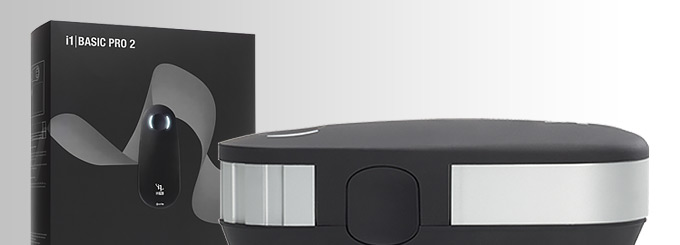
An
important thing to consider for most users is how a screen will perform out of
the box and with some basic manual adjustments. Since most users won't have
access to hardware colorimeter tools, it is important to understand how the
screen is going to perform in terms of colour accuracy for the average user.
We restored our graphics card to default settings
and disabled any previously active ICC profiles and gamma corrections. The
screen was tested at default factory settings using our new
X-rite i1
Pro 2 Spectrophotometer combined with
LaCie's Blue Eye Pro software suite. An X-rite i1 Display Pro colorimeter was
also used to verify the black point and contrast ratio since the i1 Pro 2
spectrophotometer is less
reliable at the darker end.
Targets for these tests are as follows:
-
CIE Diagram - validates the colour space
covered by the monitors backlighting in a 2D view, with the black triangle representing the
displays gamut, and other reference colour spaces shown for comparison
-
Gamma - we aim for 2.2 which is the default
for computer monitors
-
Colour temperature / white point - we aim
for 6500k which is the temperature of daylight
-
Luminance - we aim for 120
cd/m2, which is
the recommended luminance for LCD monitors in normal lighting conditions
-
Black depth - we aim
for as low as possible to maximise shadow detail and to offer us the best
contrast ratio
-
Contrast ratio - we aim
for as high as possible. Any dynamic contrast ratio controls are turned off here
if present
-
dE average / maximum -
as low as possible.
If DeltaE >3, the color displayed is significantly different from the
theoretical one, meaning that the difference will be perceptible to the
viewer.
If DeltaE <2, LaCie considers the calibration a success; there remains a
slight difference, but it is barely undetectable.
If DeltaE < 1, the color fidelity is excellent.

Default Performance and
Setup

The 38UC99 is factory calibrated
according to a 'quality assurance report' provided in the box. While this report
tells you that it has been calibrated to 2.2 gamma, 6500k white point and dE <
5, it is a little unclear which mode it is referring to. We can only assume it
is calibrated in the default setup of the screen which would be the 'custom'
picture adjust mode. The report provided with our test sample is shown
below for reference:

Default settings of the screen were as follows:
|
Monitor OSD Option |
Default Settings |
|
Preset Picture Adjust mode |
Custom |
|
Brightness |
100 |
|
Contrast |
70 |
|
Gamma |
1 |
|
Color Temp |
Custom |
|
RGB |
50, 50, 50 |

LG 38UC99 - Default Settings



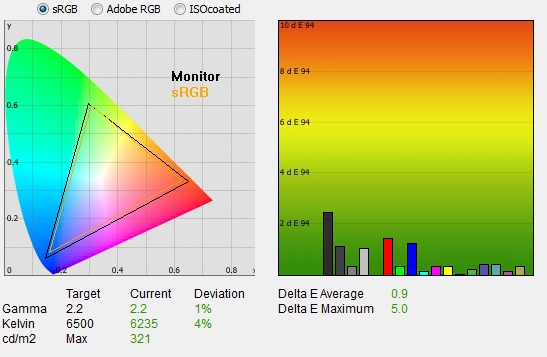

|
|
Default Settings |
|
luminance (cd/m2) |
321 |
|
Black Point (cd/m2) |
0.375 |
|
Contrast Ratio |
857:1 |
Initially out of the box the screen was set in the
default custom preset mode. With the maximum 100% brightness setting out of the
box the screen was overly bright and uncomfortable to use, so you will
definitely need to turn that down. You could tell the screen was using a
standard gamut backlight as well with the naked eye, and the colour balance and
temperature felt pretty good.
We went
ahead and measured the default state with the i1 Pro 2. The
CIE diagram on the left of the image confirms that the monitors colour gamut
(black triangle) is fairly equal to
the sRGB colour space. There is some minor over-coverage in greens and blues,
and some very minor under-coverage in reds but not by anything significant.
Default gamma was recorded at 2.2 average, leaving it with a minor 1% deviance
from the target which was great news. We tested the other gamma settings
available in the OSD menu which returned gamma0 = 2.0 average (10% deviance) and
gamma2 = 2.4 average (8% deviance). The default gamma1 setting was obviously
optimal here and close enough to our target to offer a reliable setup. That's
good news, as gamma can be tricky to correct without a calibration device. White
point was measured at a reasonably accurate 6235k, being 4%
out from the 6500k we'd ideally want for desktop use. We tested some of the
other preset modes and the 'photo' mode provided pretty much the same setup as
this default 'custom' mode, except white point was a little better at 6507k (1%
out). However, you do lose access to a lot of the picture and colour settings in
that 'photo' preset mode, so probably best to stick to the 'custom' mode and use
some of our settings.
Luminance was recorded at an extremely bright 321
cd/m2 which is
too high for prolonged general use. The screen was set at a default
100% brightness in the OSD menu but that is easy to change of course to reach a
more comfortable setting without impacting any other aspect of the setup. The
black depth was 0.375 cd/m2 at this default
brightness setting, giving us a moderate (for an IPS-type panel) static contrast ratio of
857:1.
Colour accuracy was very good out of the box
with an average dE of 0.9. Testing the screen with colour
gradients showed smooth transitions in all shades, with some gradation evident
in darker tones. Overall this default setup was very good and we were pleased
with the results. A good factory calibration from LG here.

Calibration
We used the
X-rite i1 Pro 2
Spectrophotometer combined with the LaCie Blue Eye Pro software package to
achieve these results and reports. An X-rite i1 Display Pro colorimeter was used
to validate the black depth and contrast ratios due to lower end limitations of
the i1 Pro device.
|
Monitor OSD Option |
Calibrated Settings |
|
Preset Picture Adjust mode |
Custom |
|
Brightness |
24 |
|
Contrast |
70 |
|
RGB |
47, 45, 63 |
|
Gamma |
1 |
|
Colour Temp |
Custom |

LG 38UC99 - Calibrated Settings


|
|
Calibrated Settings |
|
luminance (cd/m2) |
119 |
|
Black Point (cd/m2) |
0.135 |
|
Contrast Ratio |
879:1 |
We stuck to the 'custom' preset mode which
offered us access to the RGB controls from within the menu. We adjusted the RGB
channels and brightness setting as shown in the table above. All these OSD
changes allowed us to obtain an optimal hardware starting point and setup before software level changes would be
made at the graphics card level. We left the LaCie software to calibrate
to "max" brightness which would just retain the luminance of whatever brightness
we'd set the screen to, and would not in any way try and alter the luminance at
the graphics card level, which can reduce contrast ratio. These adjustments
before profiling the screen would help preserve tonal values and limit
banding issues. After this we let the software carry out the LUT adjustments and create an
ICC profile.
Average gamma was now corrected to 2.2 average
with a 0% deviance, correcting the minor 1% deviance we'd seen out of the box. The
white point had now been corrected to 6493k, which corrected the 4% deviance
we'd seen out of the box. Luminance had been improved thanks to the adjustment
to the brightness control and was now being measured at 119
cd/m2. This
left us a black depth of 0.135 cd/m2 and gave us a moderate static
contrast ratio (for an IPS-type panel) of
879:1. Colour accuracy of the resulting
profile was excellent, with dE average of 0.4 and maximum of 1.0. LaCie would
consider colour fidelity to be very good overall.
Testing the screen with various colour gradients
showed smooth transitions. There was some gradation in darker tones
but no banding introduced due to the adjustments to the
graphics card LUT from the profilation of the screen.
You can use our settings and
try our calibrated ICC profile if you wish, which are available in
our ICC profile database. Keep in mind that results will vary from one
screen to another and from one computer / graphics card to another.

Calibration Performance Comparisons

The comparisons made in this section try to give
you a better view of how each screen performs, particularly out of the box which
is what is going to matter to most consumers. When comparing the default factory
settings for each monitor it is important to take into account several
measurement areas - gamma, white point and colour accuracy. There's no point
having a low dE colour accuracy figure if the gamma curve is way off for
instance. A good factory calibration requires all 3 to be well set up. We have
deliberately not included luminance in this comparison since this is normally
far too high by default on every screen. However, that is very easily controlled
through the brightness setting (on most screens) and should not impact the other
areas being measured anyway. It is easy enough to obtain a suitable luminance
for your working conditions and individual preferences, but a reliable factory
setup in gamma, white point and colour accuracy is important and not as easy to
change accurately without a calibration tool.
From these comparisons we can also compare the
calibrated colour accuracy, black depth and contrast ratio. After a calibration
the gamma, white point and luminance should all be at their desired targets.

Default setup of the screen out of the box was
very good thanks to the factory calibration. You have a reliable gamma curve
with 2.2 average and a minor 1% deviance, along with a pretty accurate white
point, being slightly too warm at 6235k (4% out). The colour accuracy is also
excellent with an average dE of only 0.9. We were pleased with the out of the
box performance and this should represent a decent setup for most people, and
those without a calibration device need not worry. Some of the other ultra-wide
screens we've tested have been pretty good out of the box too. For instance the
34"
Dell U3415W had a reliable setup, as you can see from the above table. The 34"
LG 34UM95 and gaming ultra-wides like the
Acer Predator X34 /
XR341CK showed a
little more deviance from the targets when it came to gamma, but were still
pretty decent.


The display was only moderate when it came to
calibrated contrast ratio for an IPS-type panel. At 879:1 it was a little shy of
the other ultra-wide IPS models we've tested in the past, which all surpassed
the 1000:1 mark. Still, the contrast ratio wasn't terrible or anything, just not
quite as high as we might have liked from a modern, newly produced IPS panel. Some IPS-type
screens are starting to reach up to around 1200:1 nowadays. For instance the
Dell U2417HJ (1228:1 - not shown) is our current champion when it comes to IPS
technology. Of course
none of these IPS panels can compete with VA panel types which can reach over 2000:1 easily, and
commonly up to 3000:1 (e.g.
Acer Predator Z35), even to 4000:1 in the case of the
Philips BDM4065UC shown here.
|
Check Pricing and Buy - Affiliate Links
|
|
Amazon
|
|
TFTCentral is a participant
in the Amazon Services LLC Associates Programme, an affiliate
advertising programme designed to provide a means for sites to earn
advertising fees by advertising and linking to Amazon.com, Amazon.co.uk,
Amazon.de, Amazon.ca and other Amazon stores worldwide. We also
participate in a similar scheme for Overclockers.co.uk. |

Viewing Angles

Above: Viewing
angles shown from front and side, and from above and below. Click for
larger image
Viewing angles of the screen were very good as you
would expect from an IPS-type panel. Horizontally there was very little colour
tone shift until wide angles past about 45°. A slight darkening of the image
occurred horizontally from wider angles as you can see above as the contrast
shifted slighting. Contrast shifts were slightly more noticeable in the vertical
field but overall they were very good. The screen offered the wide viewing
angles of IPS technology and was free from the restrictive fields of view of TN
Film panels, especially in the vertical plane. It was also free of the
off-centre contrast shift you see from VA panels and a lot of the quite obvious
gamma and colour tone shift you see from some of the modern VA panel type
offerings.
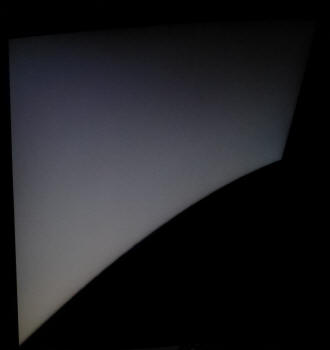
Above: View of an
all black screen from the side. Click for larger version
On a black image there is a characteristic pale glow
introduced to the image when viewed from a wide angle, commonly referred to as
IPS glow. This type of glow is common on most modern IPS-type panels and can be
distracting to some users. If you view dark content from a normal head-on
viewing position, you can actually see this glow as your eyes look towards the
edges of the screen. Because of the sheer horizontal size of this 37.5" panel,
the glow towards the edges is more obvious than on small screens, where there
isn't such a long distance from your central position to the edges. Some people
may find this problematic if they are working with a lot of dark content or
solid colour patterns. In normal day to day uses, office work, movies and games
you couldn't really notice this unless you were viewing darker content. If you
move your viewing position back, which is probably likely for movies and games,
the effect reduces as you do not have such an extreme angle from your eye
position to the screen edges. The glow effect was a little less than on flat
ultra-wide screens as the curved nature created a smaller angle between your
eyes and the edges of the screen.

Panel Uniformity
We wanted to test
here how uniform the brightness was across the screen, as well as identify any
leakage from the backlight in dark lighting conditions. Measurements of the
luminance were taken at 36 points across the panel on a pure white background.
The measurements for luminance were taken using BasICColor's calibration
software package, combined with an X-rite i1 Display Pro colorimeter with a
central point on the screen calibrated to 120 cd/m2. The below
uniformity diagram shows the difference, as a percentage, between the
measurement recorded at each point on the screen, as compared with the central
reference point.
It is worth
noting that panel uniformity can vary from one screen to another, and can depend
on manufacturing lines, screen transport and other local factors. This is only a
guide of the uniformity of the sample screen we have for review.

Uniformity of Luminance

The luminance uniformity of the screen was
decent overall. There was a drop in
luminance towards the sides of the screen, more so on the left, where in the
worst case the luminance dropped to 102
cd/m2
(-19%). That was the most extreme example though and in fact 95% of the
screen was within a 10% deviance from the centrally calibrated point which
was very good.

Backlight Leakage
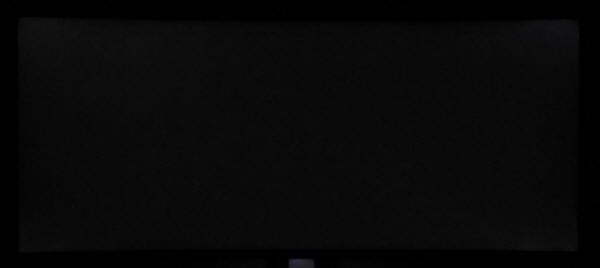
Above: All black screen in a darkened room. Click for larger version
We also tested the screen with an all black image
and in a darkened room. A camera was used to capture the result. The camera
showed there was no real backlight bleed evident, but a little clouding from the
four corners. Note that this picture was taken from a suitable distance to
eliminate capturing viewing angle related IPS glow, which
as we've said
already may become a problem for some users on a screen this size.
Note: if you want to test your own screen for
backlight bleed and uniformity problems at any point you need to ensure you have
suitable testing conditions. Set the monitor to a sensible day to day brightness
level, preferably as close to 120
cd/m2 as you can get it (our tests are
once the screen is calibrated to this luminance). Don't just take a photo at the
default brightness which is almost always far too high and not a realistic usage
condition. You need to take the photo from about 1.5 - 2m back to avoid
capturing viewing angle characteristics, especially on IPS-type panels where
off-angle glow can come in to play easily. Photos should be taken in a darkened
room at a shutter speed which captures what you see reliably and doesn't
over-expose the image. A shutter speed of 1/8 second will probably be suitable
for this.

Support TFTCentral,
buy the LG 38UC99 using our affiliate link

General and Office Applications

One of the key selling points of ultra-wide
screens like the this is it's high resolution and large screen size. The 3840 x
1600 display offers a sharp but comfortable picture. Its pixel area is about 2.2
times larger than an Ultra-Wide Full HD 21:9 monitor (2560 x 1080), and about 3
times larger than a Full HD 16:9 monitor (1920 x 1080). It provides an efficient
environment for using Microsoft Office programs and internet browsing, and split
screen working is a pleasure. You can comfortably have the screen split in to 3
vertical sections if you want which is very nice. Thankfully the high resolution
is of a very comfortable size on the 37.5" panel, with a 0.229mm pixel pitch it
is very comparable to a 27" 2560 x 1440 monitor (0.2331mm) and the popular
ultra-wide 34" 3440 x 1440 displays (0.2325mm). This means you are basically
getting a slightly wider and slightly higher desktop area than the 34" models,
with a similar font size. If you're coming from a lower resolution / larger
pixel pitch you may still find the fonts look quite small to start with, but
like the 27" 1440p models out there you soon get used to it. We continue to
enjoy the curved format of these displays for day to day office work. It just
felt more comfortable than a flat screen on a model as wide as this, bringing
the corners a bit nearer to you. You didn't really notice the curve in normal
use but we liked the feel. Probably down to user taste, so if in doubt try and
see one in person.
The thin
bezel design mean that the 38UC99 could be integrated into a
multi-screen set up if you wanted as pictured above, although with the screen as
big as it is, you'd need a very big desk! The light AG coating of the panel is
welcome, and much better than the grainy and 'dirty' appearance of older IPS AG
coatings. The
wide viewing angles provided by this panel technology on both horizontal and
vertical planes, helps minimize on-screen colour shift when viewed from
different angles, making colour work and photo viewing a pleasure. The default
factory setup of the screen was very good as
well, offering an accurate gamma curve, accurate white point, pretty decent contrast ratio and low dE.
The brightness
range of the screen was also very good, with the ability to offer a luminance
between 309 and 54 cd/m2. This should mean the screen is perfectly
useable in a wide variety of ambient light conditions, including darkened rooms.
A setting of ~25 in the OSD brightness control should return you a luminance
close to 120 cd/m2 out of the box. On another positive note, the brightness regulation is controlled
without the need for the use of the now infamous
Pulse-Width Modulation (PWM), and so those who suffer from eye fatigue or
headaches associated with flickering backlights need not worry.
There was no audible noise or buzzing from the screen, even when specifically
looking for it using test images with a large amount of text at once. The screen
also remains cool even during prolonged use.

By using the LG 'On Screen
Control' software, users can select from 14 different Screen Split options to
optimize Multi-tasking Windows organization and screen real estate use. The
additional 'Dual Linkup' function means two individual devices can be connected
to the monitor in a 1:1 aspect ratio, allowing the monitor to divide up the
screen for both outputs. Whilst those two devices are shown in a single monitor,
users can even share the contents from one device to the other.
There are a few extras provided here as well
including a 2x port USB 3.0 hub on the back, one with charging support as well from
one of them. There is an audio output for headphone connection if you want, with
the display also offering 2x 10W stereo speakers. The provided Bluetooth dongle
is a nice feature, allowing you to pair your phone or other Bluetooth device
with the screen and play music etc through the speakers. There
were no further extras such as ambient light sensors or card readers on this
model which can be useful in office environments.
There was a reasonable range of ergonomic adjustments available from the stand
allowing you to obtain a comfortable position for a wide variety of angles of
tilt, and a decent height adjustment range. Side to side swivel was sadly
missing though. The
VESA mounting support may also be useful to some people as well.

Responsiveness and Gaming
|
Quoted G2G Response Time |
5ms G2G |
|
Quoted ISO Response Time |
14ms |
|
Panel Manufacturer and
Technology |
LG.Display AH-IPS |
|
Panel Part |
LM375QW1-SSA1 |
|
Overdrive Used |
Yes |
|
Overdrive Control Available to
User |
Response Time |
|
Overdrive Settings |
Off, Slow, Normal, Fast |
The 38UC99 is rated by LG as having a 5ms G2G
response time which indicate the panel uses
overdrive /
response time compensation (RTC) technology to boost pixel transitions
across grey to grey changes. The
part
being used is the
LG.Display LM375QW1-SSA1 AH-IPS panel. Have a read about response time in
our
specs section if you need additional information about this measurement.
We will first test the screen using our thorough
response time testing method. This uses an oscilloscope and photosensor to
measure the pixel response times across a series of different transitions, in
the full range from 0 (black) to 255 (white). This will give us a realistic view
of how the monitor performs in real life, as opposed to being reliant only on a
manufacturers spec. We can work out the response times for changing between many
different shades, calculate the maximum, minimum and average grey
to grey (G2G) response times, and provide an evaluation of any overshoot present
on the monitor.
We use an
ETC M526
oscilloscope for these measurements along with a custom photosensor device.
Have a read of
our response time measurement article for a full explanation of the testing methodology and reported
data.

'Response Time' Setting (Overdrive)
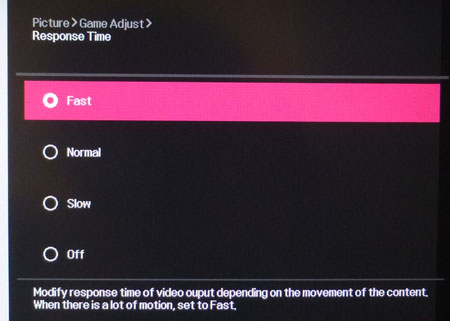
The 'response time' setting is available via the
picture > game adjust section of the OSD menu as shown above. We will test all
four modes to see
which is optimal first of all. Note that these results were the same from an NVIDIA and AMD test system, and
at 60Hz and 75Hz refresh rate.




In the 'off' setting the response times were slow
as you might expect from an IPS panel without overdrive. There was an average
G2G response time of 18ms measured, but some transitions ranged up to 25 - 30ms.
There was no overshoot since the overdrive impulse was turned off. When you turn
the response time setting up a notch to 'slow' there is only a very slight
change in response times, now measured at 16.4ms G2G average. Again, a change to
'normal' only makes a minor improvement down to 13.9ms G2G average. Even
boosting the response times up to the maximum 'fast' mode gives you only an
10.8ms G2G average. At that setting you start to get some high overshoot
creeping in on some transitions, although in practice it isn't overly obvious we
found.
The IPS panel seems to struggle a bit when it
comes to pixel response times which is a shame. The overdrive circuit attempts
to boost them by the time you reach the maximum 'fast' setting, but the
overshoot is then starting to become a problem. To give you an idea, a decent
60Hz IPS panel can reach about 8.5ms G2G without any overshoot in the best cases
we've seen, so the LG 38UC99 is falling quite a bit short of that unfortunately.
The screen isn't really aimed at gamers, despite carrying a few gaming features
so this was perhaps not a key concern of LG. We'll talk a bit more about
perceived motion clarity and performance in the following sections. For now,
we'd probably recommend using the 'fast' response time setting despite the
overshoot as the clarity is better and image is sharper. If you find the
overshoot distracting for your particular uses, revert to the 'normal' setting.
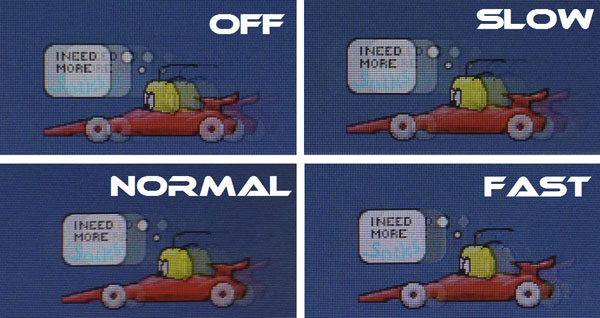
The above examples from the PixPerAn tool should
give you a further indication of the motion clarity, blurring etc seen in each
of the response time settings.

Detailed Response Time Measurements
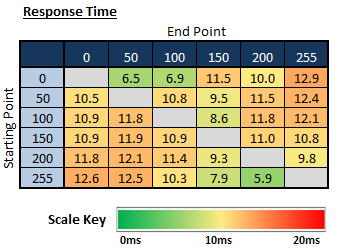
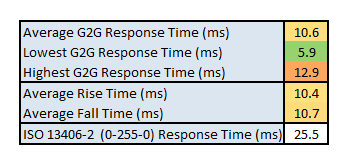
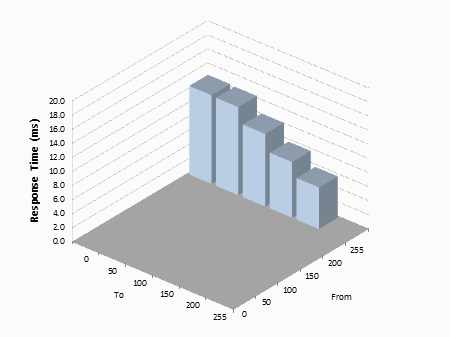
We stuck with what we consider to be the optimal 'fast'
response time setting. We know from our tests in the previous section that this
returned the fastest response times possible from this panel, although we have
to live with some high levels of overshoot creeping in on some transitions. The
average G2G response time was measured at 10.6ms which was a little slow overall
for a standard refresh rate IPS-type panel. Rise times (changes from dark to light shades)
were basically the same on average as fall times (changes from light to dark
shades). The lowest response time measured was 5.9ms, almost reaching the
advertised 5ms G2G figure.
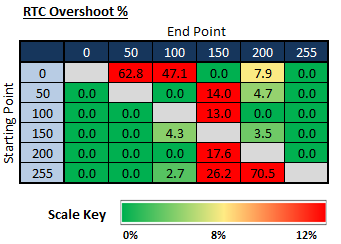
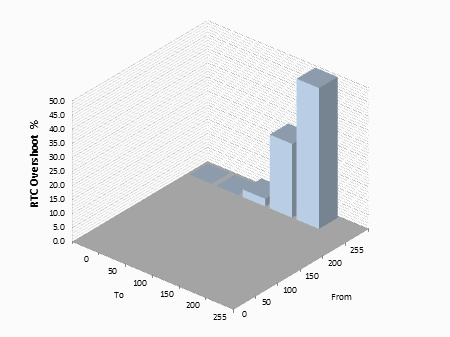
If we evaluate the Response Time Compensation
(RTC) overshoot then the results are mixed. There are a hand full of transitions
where overshoot is very high, particularly those like 0 > 50 and 255 > 200 where
the response times had been driven down to their lowest levels (6.5 and 5.9ms
respectively). The overshoot was not evident on a huge portion of transitions
and so in practice it didn't seem too severe. We still favoured this moderate
overall overshoot to the slower 'normal' response time setting, as it returned a
sharper and crisper motion clarity. As we said before, if you find overshoot
becomes distracting, drop back to the 'normal' response time mode.

Display Comparisons
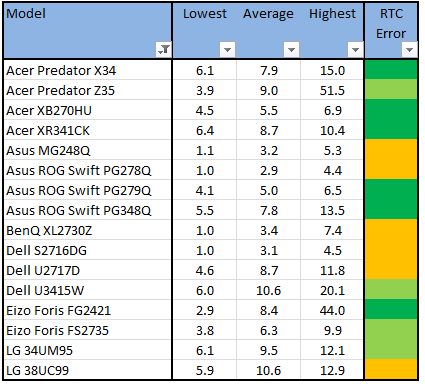
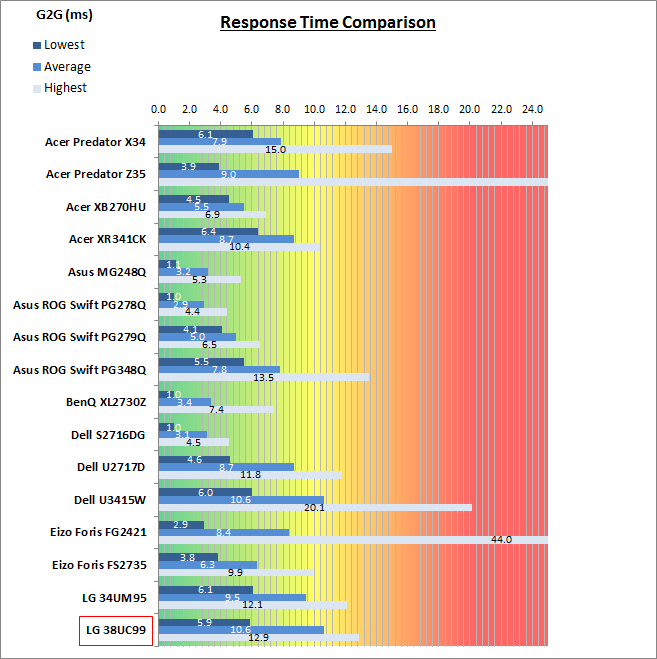
The above comparison table and graph shows you the
lowest, average and highest G2G response time measurement for each screen we
have tested with our oscilloscope system. There is also a colour coded mark next
to each screen in the table to indicate the RTC overshoot error, as the response
time figure alone doesn't tell the whole story.
The response time performance of the LG 38UC99 was
a bit slower than many of the other IPS panels tested here, certainly when you
compare it to the high refresh range (100Hz and above). With an average G2G
response time of 10.6ms measured for the LG with moderate to high overshoot, it
was a bit slower than the best case 60/75Hz IPS models which can reach down to
around 8.5ms G2G without introducing any overshoot. It was also a bit slower,
and with more overshoot, than ultra-wide models like the
Dell U3415W and
LG 34UM95. High refresh rate 144Hz IPS-type panels
like the
Asus ROG Swift PG279Q and
Acer XB270HU can reach lower response times of around 5ms G2G thanks to the
boosted refresh rate. TN Film models with high 144Hz refresh rate like the
Asus ROG Swift PG278Q and
Dell S2716DG reach even lower at around 2.9 - 3.1ms for instance with
moderate overshoot.
The screen was also tested using the chase test in
PixPerAn for the following display comparisons. As a reminder, a series of
pictures are taken on the highest shutter speed and compared, with the best case
example shown on the left, and worst case example on the right. This should only
be used as a rough guide to comparative responsiveness but is handy for a
comparison between different screens and technologies as well as a means to
compare those screens we tested before the introduction of our oscilloscope
method.

37.5"
5ms
G2G LG.Display AH-IPS (Response Time = Fast)
In practice the LG 38UC99 showed moderate levels
of blurring on moving images with some overshoot appearing in some transitions.
There wasn't much overshoot detected in these specific colour transitions in the
PixPerAn tool, but we know from our oscilloscope tests that some transitions
show a high overshoot. We still felt this 'fast' response time setting returned
a slight sharper and clearer moving image than the 'normal' mode.

37.5"
5ms
G2G LG.Display AH-IPS (Response Time = Fast)

34"
4ms
G2G LG.Display AH-IPS @ 100Hz (OD = Normal)

34"
4ms
G2G LG.Display AH-IPS @ 100Hz (OD = Normal)

34"
4ms
G2G LG.Display AH-IPS @ 75Hz (OD = Normal)

34"
8ms
G2G LG.Display AH-IPS (Response Time = Normal)

34"
5ms
G2G LG.Display AH-IPS (Response Time = Middle)
We can compare the 38UC99 to some of the other
ultra-wide screens we have tested here as well. The 34" gamer-oriented
Acer Predator X34 and
Asus
ROG Swift PG348Q can both be overclocked to 100Hz, and that results in an
improvement to the response times, which makes them a better gaming option than
the LG screen. They have smoother and sharper moving images and the boosted
refresh rate really makes a difference of course. The more generalist 34"
Dell U3415W and
LG 34UM95
are a little closer to the LG 38UC99 in responsiveness, showing a fairly similar
level of blurring to the moving image. Although those two models are free from
any obvious overshoot, and so put them a little ahead of the 38UC99.

Refresh Rate and FreeSync

The 38UC99 supports a refresh rate of 60Hz
natively, but this can be boosted up to 75Hz simply from within your graphics
card settings. When enabled, and from a compatible system, FreeSync is also
available which operates in a range between 52 and 75Hz.
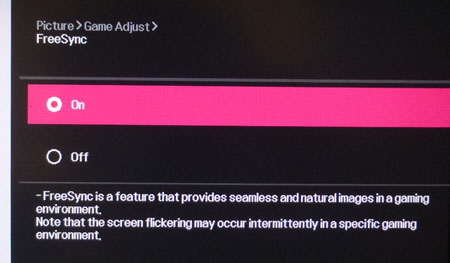
From an NVIDIA test system (GTX 970) we found
stable performance without any frames being dropped at 60Hz, which you would
certainly hope for. However, when we increased the refresh rate up to 75Hz
frames began to be dropped quite noticeably. Even basic motion tests like the
PixPerAn tool showed consistent stuttering and jumping movements and the
BlurBusters.com frame skipping test showed obvious frame skipping as well
unfortunately. We couldn't find a way to resolve this unfortunately, so it looks
as if from NVIDIA systems, you are limited to 60Hz refresh rate. See the
following
section though for how the Blur Reduction function works from an NVIDIA
system.
From an AMD system (Radeon R9 290 series) we had
better results. At 60Hz there was no frame skipping at all. Initially when you
boost the refresh rate up to 75Hz in Windows you get the same obvious frame
skipping as from the NVIDIA system, which was worrying at first. However, all
you need to do is enable the FreeSync option from within the OSD and that seems
to fix the issue. Even if you turn FreeSync off from the AMD control panel, the
75Hz operation then works properly without frame skipping. Using the BlurBusters
test again showed no frame drops at 75Hz synced refresh rate, and the PixPerAn
motion tests showed smooth, stutter-free movement. So if you want to use 75Hz
refresh rate, make sure you've enabled FreeSync within the OSD first, regardless
of whether you're going to enable it from your graphics card or not. This trick
didn't work sadly from an NVIDIA system, we did try. You will get some minor
improvements in perceived motion clarity through the increase of the refresh
rate from 60Hz to 75Hz on an AMD card, due to the increase frame rate and
refresh rate. It's not as significant as moving from a 60Hz to a 120Hz/144Hz
refresh rate panel, but it's a small improvement at least. The added FreeSync
support is certainly welcome given the high resolution of this screen, as
powering 3840 x 1600 at a consistent 75Hz is going to be a challenge for many
systems and graphics cards. The FreeSync dynamic range between 52 - 75Hz will
help eliminate tearing and other issues you might face otherwise, as frame rate
fluctuates. Do keep in mind that even with FreeSync available here, there is a
huge strain on your system to run a resolution like this.

1ms Motion Blur Reduction Mode

This is a new feature LG are advertising on some
of their screens now, the so-called "1ms Motion Blur Reduction" mode. We can
confirm that on the LG 38UC99 this is in fact an added strobed backlight
feature, designed to help reduce perceived motion blur in practice. Our in depth
article about
Blur Reduction Backlights talks more about these methods and how they help
reduce motion blur for the user, so it's well worth having a read of that if
this principle is new to you. This strobed backlight on the 38UC99 is not linked
specifically to AMD FreeSync (like ULMB is linked to NVIDIA G-sync) and we're pleased
to confirm you can use this feature from NVIDIA cards as well as AMD.
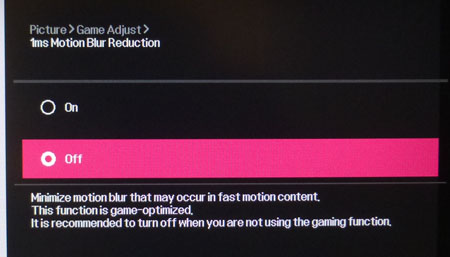
The 1ms Motion Blur Reduction setting is available
in the OSD menu in the 'game adjust' section, and is only available when you've
set the screen to a 75Hz refresh rate in Windows. It is greyed out at 60Hz. If
you enable it with FreeSync active, it also turns off the FreeSync setting in
the OSD menu, so as expected it is not possible to use both at the same time.
Actually, that is a little annoying, as when you want to turn Blur Reduction
off, you also have to re-enable FreeSync if you were using it. It also requires
you to drill in to the menu a few levels to get to these settings, and maybe it
would have been handy to be able to make this setting one of the quick access
options instead if you wanted. Since the feature is only available at 75Hz you
may wonder whether that makes it unusable from an NVIDIA system, since we found
in our
previous section that frames were dropped very noticeably at 75Hz from
NVIDIA cards. In fact, if you run an NVIDIA system at 75Hz with this Blur
Reduction mode enabled, it doesn't seem to drop any frames any more and you get
a smooth, stutter-free movement in simple motion tests which before were very
stuttery and jumpy. The BlurBusters frame skipping test also showed no frame
drops. So it seems you can at least use this feature from an NVIDIA
system without issue at 75Hz, you just can't run the screen at 75Hz refresh rate
normally for some reason.
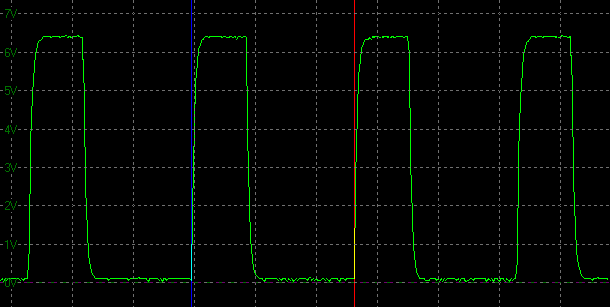
Blur Reduction
Mode Strobing at 75Hz, scale = 5ms
Once enabled, we can test the strobing via our
oscilloscope as shown above. The strobing cycles the backlight completely off
and on in sync with the refresh rate of the screen. So each strobe lasts
13.33ms, and there's 75 strobes per second (75Hz). This is both a good and bad
thing. On the one hand, at 75Hz the strobing is pretty visible to the naked eye,
certainly when you switch it on in desktop use the flicker is very obvious and
hard on the eyes. Typically strobed backlights are not available on screens
unless they can support high refresh rates natively. Then they tend to be
available with an 85Hz typical minimum option, ranging up to 100, 120 and 144Hz
in some cases. It's preferable to run the strobing at the highest supported
refresh rate frequency since it helps reduce the visible flicker and offers an
improved experience in terms of blur reduction (at the cost of some slight
brightness reduction admittedly). Even the 85Hz lowest option tends to be
problematic to many people as the flicker is too noticeable and hard on the
eyes. Here on the 38UC99 the maximum available refresh rate is 75Hz and so you
are more limited in its operation and will have to live with some visible
flicker in some situations. In dynamic content like gaming, it is less obvious
and harder to see but may still add a strain to the eyes for some users. You
certainly wouldn't want to enable it for any other uses that's for sure. User
experience and susceptibility to the flicker will vary from person to person,
but it's likely to be hard on the eyes for a large portion of users we expect.
The other option which can be used by
manufacturers is to use a "double strobe" system, where the strobing is done
twice per frame. In this scenario at 75Hz that would in theory result in 150
strobes per second. That might seem a better option as it would certainly be
less harmful on the eyes and the visible flicker would be significantly reduced
or eliminated for some users. However, double strobing isn't a great system we
have seen in the past as it tends to lead to double images and ghosting issues
on moving content. So here, LG have at least stuck with a single strobe system
which makes it useable, albeit with the risks of some visible flicker to the
user.
|
Brightness
Setting with Blur Reduction Enabled |
Luminance
(cd/m2) |
|
100 |
213.0 |
|
75 |
167.1 |
|
50 |
119.7 |
|
25 |
70.0 |
|
0 |
18.5 |
Enabling the Blur Reduction backlight has a usual
impact on the luminance of the display. Thankfully you can still alter the
brightness setting in the OSD menu although it should be noted that there are no
other controls or options to adjust the strobe timing or strobe length or
anything like that. A consideration for users of these blur reduction backlights
is the maximum brightness you can still achieve with the feature enabled. Here,
it is a decent 213
cd/m2 which is still pretty bright and at least should allow the
feature to be used for gaming where brightness needs to be a little higher than
normal every day use. Unfortunately, the menu does not remember a brightness
setting for Blur Reduction on and off modes, so you have to manually change the
brightness slider when you enable Blur Reduction, and then when you turn it back
off (unless you just stick with the same brightness setting of course). A
typical every day brightness of around 25% would be comfortable for normal
desktop use, but when you enable blur reduction the resulting 70
cd/m2 may be too dark for gaming.
|
Model |
Refresh Rate |
Max Normal
Luminance
Blur Reduction Off
(cd/m2) |
Max Luminance
Blur Reduction On
(cd/m2) |
|
Acer XB270HU* |
100Hz* |
327 |
111 |
|
Acer Predator Z35 |
120Hz |
359 |
111 |
|
Asus ROG Swift PG278Q |
120Hz |
385 |
123 |
|
Asus ROG Swift PG279Q |
120Hz |
331 |
101 |
|
BenQ XL2720Z |
144Hz |
282 |
119 |
|
BenQ XL2730Z |
120Hz |
309 |
191 |
|
Dell S2716DG |
120Hz |
328 |
118 |
|
Eizo FG2421 |
120Hz |
386 |
257 |
|
Eizo FS2735 |
144Hz |
331 |
180 |
|
LG 38UC99 |
75Hz |
308 |
213 |
Note:
Pulse Width setting at max where applicable.
*Note 2: The Acer XB270HU was later updated to include a 120Hz mode, which will
produce a slightly darker maximum luminance
If we compare the max luminance of all the screens
we've tested with a blur reduction strobed backlight we can see that the LG
offers a brighter display than most of the other options, which is a good thing.
Yes, the frequency of the strobing has some impact and at 75Hz it is quite a lot
lower than the frequency of the other displays, as we've already talked about
above.
Blur Reduction Tests

Pursuit
camera photo from central area of the screen
Of course the main thing we want to test is what
improvements the Blur Reduction mode offers when it comes to motion clarity and
gaming. We were pleased with the results we'd seen from LightBoost backlights
when we tested them, and also from the natively supported blur reduction
feature on other displays including the popular gaming models we've tested as
listed above. We were pleased with the results here from the Blur Reduction
backlight. Tracking of moving objects became much easier and the image looked
sharper and clearer. As we've already said, there's only one refresh rate that
this works at (75Hz) so you are a little limited, and will have to live with
some possible flicker issues due to the low strobing frequency. The above
pursuit camera image gives you an idea of the image sharpness and clarity with
this feature enabled. This was taken from the centre area of the screen where
the image is clearest. Because the response times were fairly slow (certainly
compared with fast TN Film models), you still get some ghosting images behind
the moving object, although it looks sharper and clearer thanks to the strobing
backlight.
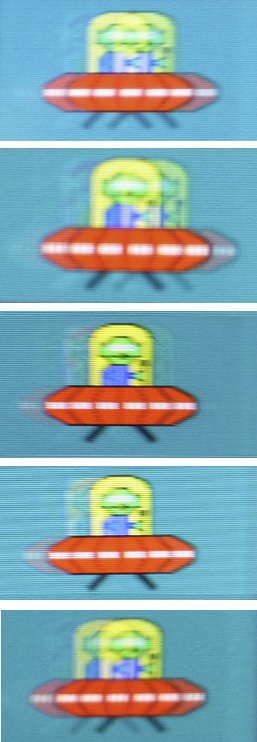
Pursuit
camera photos representing strobe cross talk from top to bottom regions of the
screen.
We used the BlurBusters full-screen
TestUFO online motion test as
well, to help establish the image clarity at different areas of the screen. This
is represented by the image above which gives you a sample from 5 areas of the
screen, from top to bottom. The
middle region of the screen was the clearest with some strobe cross-talk
becoming evident as you reached the top and bottom. LG seemed to have got the
strobe timing at a nice level to maximise performance in the central region
though which was good, as that's where most of your focus is in games. It is
impossible to eliminate strobe cross-talk completely due to the way they
operate, but the important thing is whereabouts on the screen this manifests
itself and to what level. The central region is probably the most important
since that's where a lot of your gaming focus will be, where crosshairs and the
likes are. This was a pretty decent implementation of a strobe backlight system
here, especially since there is a refresh rate limitation here (75Hz max) and
most manufacturers wouldn't attempt to add a feature like this unless the screen
supported 120Hz refresh rate at least. It's not perfect, as the frequency is low
and flicker may well be problematic to some users. The response times also
aren't particularly fast so you don't get the nice clear image you might get
from other blur reduction screens. However, at least it is
offered as an option if you want to try it, or find it useful. We were also
pleased that this is a feature of the monitor itself and so can be used no
matter what your graphics card choice is. Obviously in an ideal World you could
use it with FreeSync as well, but that will take some doing from the
manufacturers to get working.

Additional Gaming Features
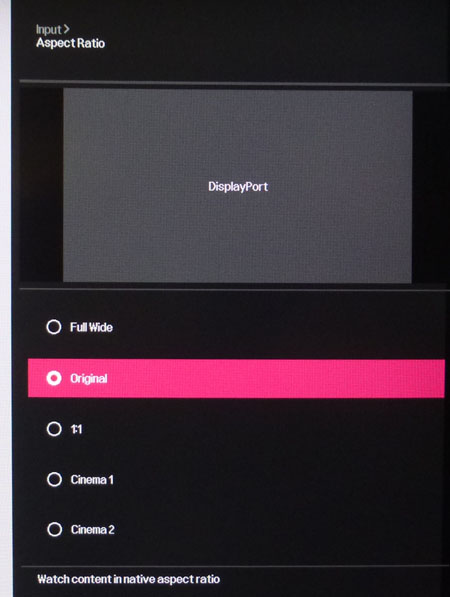
Aspect Ratio Control -
the 38UC99 has 5 options for
aspect ratio control through the OSD 'Display' menu as shown above. There
are options for full wide, original, 1:1 pixel mapping and 2 different 'cinema'
modes. The cinema modes are designed for 21:9 full screen viewing, with and
without captions. The presence of an 'original' mode to maintain the source
aspect (but fill as much of the screen as possible), and 1:1 pixel mapping
should be very useful, and certainly welcome given not all content and inputs
are this 24:10 native aspect ratio.
Preset Modes -
There are several specific game preset modes
available from the 'picture mode' menu. There are FPS Game 1, FPS Game 2, RTS
Game and Custom (Game) modes to choose from. All have differing preset values,
with some settings being locked in certain cases like sharpness and even the
response time control. These modes may be useful if you want a slightly
different setup for gaming, perhaps with accentuated sharpness and a brighter
display which would be fairly typical. You could even set a mode up to have the
Blur Reduction backlight enabled by default.
Black Stabilizer - You can adjust this
slider to change the black saturation levels in dark images, to help bring out
detail in darker scenes. Might be useful if you play a lot of darker games.

Lag
We have written an in depth article about
input lag and the various measurement techniques which are used to evaluate
this aspect of a display. It's important to first of all understand the
different methods available and also what this lag means to you as an end-user.
Input Lag vs. Display Lag vs. Signal
Processing
To avoid confusion with different terminology we
will refer to this section of our reviews as just "lag" from now on, as there
are a few different aspects to consider, and different interpretations of the
term "input lag". We will consider the following points here as much as
possible. The overall "display lag" is the first, that being the delay between
the image being shown on the TFT display and that being shown on a CRT. This is
what many people will know as input lag and originally was the measure made to
explain why the image is a little behind when using a CRT. The older stopwatch
based methods were the common way to measure this in the past, but through
advanced studies have been shown to be quite inaccurate. As a result, more
advanced tools like SMTT provide a method to measure that delay between a TFT
and CRT while removing the inaccuracies of older stopwatch methods.
In reality that lag / delay is caused by a
combination of two things - the signal processing delay caused by the TFT
electronics / scaler, and the response time of the pixels themselves. Most
"input lag" measurements over the years have always been based on the overall
display lag (signal processing + response time) and indeed the SMTT tool is
based on this visual difference between a CRT and TFT and so measures the
overall display lag. In practice the signal processing is the element which
gives the feel of lag to the user, and the response time of course can
impact blurring, and overall image quality in moving scenes. As people become
more aware of lag as a possible issue, we are of course keen to try and
understand the split between the two as much as possible to give a complete
picture.
The signal processing element within that is quite
hard to identify without extremely high end equipment and very complicated
methods. In fact the studies by Thomas Thiemann which really kicked this whole
thing off were based on equipment worth >100,1000 Euro, requiring extremely high
bandwidths and very complicated methods to trigger the correct behaviour and
accurately measure the signal processing on its own. Other techniques which are
being used since are not conducted by Thomas (he is a freelance writer) or based
on this equipment or technique, and may also be subject to other errors or
inaccuracies based on our conversations with him since. It's very hard as a
result to produce a technique which will measure just the signal processing on
its own unfortunately. Many measurement techniques are also not explained and so
it is important to try and get a picture from various sources if possible to
make an informed judgement about a display overall.
For our tests we will continue to use the SMTT
tool to measure the overall "display lag". From there we can use our
oscilloscope system to measure the response time across a wide range of grey to
grey (G2G) transitions as recorded in our
response time
tests. Since SMTT will not include the full response time within its
measurements, after speaking with Thomas further about the situation we will
subtract half of the average G2G response time from the total display lag. This should allow us to give a good estimation of
how much of the overall lag is attributable to the signal processing element on
its own.
Lag Classification
To help in this section we will also introduce a broader classification system
for these results to help categorise each screen as one of the following levels:
-
Class 1)
Less than 16ms / 1 frame lag - should be fine for gamers, even at high levels
-
Class
2)
A lag of 16 -
32ms / One to two frames - moderate lag but should be fine for many gamers.
Caution advised for serious gaming and FPS
-
Class
3)
A lag of more
than 32ms / more than 2 frames - Some noticeable lag in daily usage, not
suitable for high end gaming
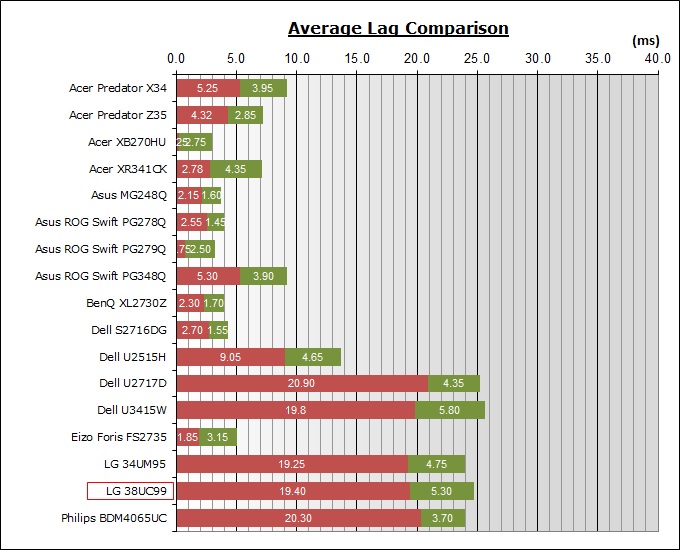
For the full reviews of the models compared here and the dates they were written
(and when screens were approximately released to the market), please see our
full
reviews index.
|
(Measurements in ms) |
|
|
Total Display Lag (SMTT
2) |
24.7 |
|
Pixel Response Time
Element |
5.3 |
|
Estimated Signal
Processing Lag |
19.4 |
|
Lag Classification |
2 |
|

Class 2 |
We have provided a comparison above against other
models we have tested to give an indication between screens. The screens
tested are split into two measurements which are
based on our overall display lag tests (using SMTT) and half the average G2G
response time, as measured by the oscilloscope. The response time is split from
the overall display lag and shown on the graph as the green bar. From there, the
signal processing (red bar) can be provided as a good estimation.
The screen showed a total average display lag of
24.7 ms as measured with SMTT 2. Taking into account half the average G2G
response time at 5.3ms, we can estimate that there is ~19.4ms of signal
processing lag on this screen which is just over 1 frame at 60Hz. This is fairly
typical result from a screen with a built in scaler and not specifically geared
at gaming with low lag.

Movies and Video

The following summarises the screens performance
in video applications:
-
37.5"
screen size makes it a good option for an all-in-one multimedia screen, but
being quite a bit smaller than most modern LCD TV's of course even at this
massive size.
-
24:10
aspect ratio is more well suited to videos, more so than the wide range of
16:9 format screens around, leaving smaller borders on DVD's and wide screen
content at the top and bottom.
-
3840 x
1600 resolution can support full 1080 HD resolution content
-
Digital interfaces support HDCP for any encrypted and protected content
-
Good range of connectivity options provided
with DisplayPort, USB type-C and 2x HDMI offered.
-
Cables provided in the box
for DisplayPort, USB type-C and HDMI (x1).
-
Light
AG coating providing clean and clear images, without the
unwanted reflections of a glossy solution.
-
Wide
brightness range adjustment possible from the display, including a maximum
luminance of ~309
cd/m2 and a decent minimum luminance
of 54 cd/m2. This should afford you good control for different
lighting conditions. Brightness regulation is
controlled without the need for PWM and so is flicker free for all brightness
settings.
-
Black
depth and contrast ratio are moderate for an IPS-type panel at 879:1 after
calibration. Most detail in darker scenes should still not be lost even though
the contrast ratio is not as strong as other competing IPS panels.
-
There
is a specific 'cinema' preset mode available for movies or video if you want
which doesn't look that dissimilar to our calibrated custom mode, other than
the brightness being at 100% and some of the other settings now being greyed
out and locked. Might be useful to set up at a specific brightness level for
movies though.
-
Adequate pixel responsiveness which should be able to handle fast moving
scenes in movies without issue. Low overshoot issues which is pleasing in the
normal mode, which you may want to stick to for movies. The 'cinema' preset
mode is locked to this response time mode in fact.
-
Wide viewing angles thanks to IPS-type panel
technology meaning several people could view the screen at once comfortable
and from a whole host of different angles.
-
IPS glow is typical, meaning you might
experience some annoying white glows on darker content from an angle.
-
Good and easy to use tilt and height ergonomic
adjustments available from the stand, although the lack of a side to side
swivel function is a shame for re-positioning the screen for movie viewing
from a distance, or with other people.
-
No
noticeable backlight leakage, and none from the edges which is
good. This type of leakage may prove an issue when watching movies where black
borders are present but it is not a problem here.
-
2x 10W
integrated stereo speakers on this model. There is also an audio output
connection for headphones if needed.
-
Decent
range of hardware aspect ratio options including 'original' aspect ratio
retention and a 1:1 pixel mapping mode.
-
Picture in picture (PiP) and Picture By Picture (PbP) are not available, other
than a half and half split screen function (PbP) for displaying two inputs at
once.

Conclusion
If you appreciate this review and enjoy reading and like our work, we would welcome a
donation
to the site to help us continue to make quality and detailed reviews for you.
This was the first screen to market in this size and format, and so it was
interesting to put the 38UC99 through our tests. First of all, the huge screen
size and high resolution was a pleasure to work with in day to day general uses,
including office applications, split screen web work and photo viewing. The 3840
x 1600 resolution is a bit of a bump from the range of 3440 x 1440 ultra-wide
models around, although not massive, but on a screen this big it offers a
comfortable pixel pitch and text size without needing to worry about operating
system scaling. The design of the screen was nice we thought with a sleek white
back and a nice set of connections and extras provided. The stand was also good
on the most part, although side to side swivel was missed a bit on a large
screen like this. LG have done a nice job offering a good range of connections,
and even providing the cables for them all in the box too. The additional
Bluetooth dongle was a nice added extra as well.
Performance wise we were impressed with the
default factory setup of the screen which should be fine for most users once you
turn the brightness down to a comfortable level. The only slight disappointment
was the moderate contrast ratio of 879:1 (after calibration) which we would have
liked to have been up over 1000:1 really for a modern IPS panel. The flicker
free backlight and light AG coating were welcome as ever. The panel provides the
usual all-round performance benefits of IPS technology, including wide viewing
angles and a stable image. There is the usual IPS-glow levels from this panel so
some users will need to be wary of that if they find this glow on dark content a
problem. It becomes more apparent given the large screen size and ultra-wide
format, although the subtle curve helps a little. The screen does very well we
felt for its target market, and for those wanting a decent all-rounder with a
large size and resolution.
When it comes to gaming the 38UC99 was an
interesting display to test. On the one hand, the screen isn't really aimed at
the gaming market, so perhaps we shouldn't expect too much. On the other hand,
there are a decent range of features included for gaming needs so it is bound to
attract some interest from that audience as a result. It's pretty good overall,
although not perfect. The panels pixel response times weren't as good as we had
hoped for from a modern IPS panel, which was a bit of a shame. The 75Hz boosted
refresh rate and FreeSync support make gaming from an AMD system a reasonable
option if you can power the high resolution effectively, although there is some
moderate lag to live with still. NVIDIA systems will be limited to 60Hz sadly,
and missing the dynamic refresh rate support of course. You can use the added
Blue Reduction backlight from either an AMD or NVIDIA system which is an
interesting addition, and quite a brave one from LG given the low supported
refresh rate. They've provided support for it here and so those who benefit from
blur reduction backlights will be pleased with the single strobe implementation,
decent enough results in practice and at least some support being provided.
There is a question of flicker at such a low refresh rate and strobing frequency
so be careful.
|
Pros |
Cons |
|
Large screen size and
resolution with comfortable pixel pitch, ideal for split screen working
and the intended market |
Pixel response times are not
as good as they could be from a modern IPS panel |
|
Very good factory calibration
and setup |
Only a moderate contrast ratio
for an IPS panel |
|
Blur Reduction backlight
provided despite limited refresh rate or 75Hz |
OSD software a bit chunky and
cumbersome |
|
Check Pricing and Buy - Affiliate Links
|
|
Amazon
|
|
TFTCentral is a participant
in the Amazon Services LLC Associates Programme, an affiliate
advertising programme designed to provide a means for sites to earn
advertising fees by advertising and linking to Amazon.com, Amazon.co.uk,
Amazon.de, Amazon.ca and other Amazon stores worldwide. We also
participate in a similar scheme for Overclockers.co.uk. |
|
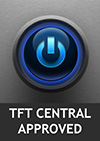
|
TFT Central Awards Explained
We have two award
classifications as part of our reviews. There's the top 'Recommended'
award, where a monitor is excellent and highly recommended by us. There is
also an 'Approved' award for a very good screen which may not be perfect,
but is still a very good display. These awards won't be given out every
time, but look out for the logo at the bottom of the conclusion. A list of
monitors which have won our awards is available
here. |